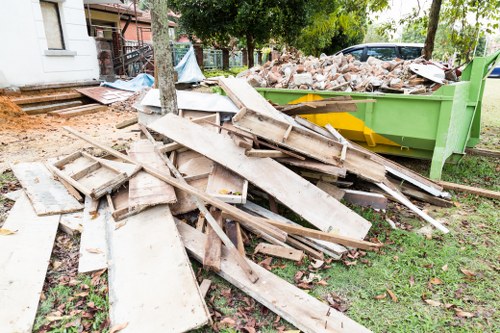Waste Clearance in Mega Rubbish
Understanding Mega Rubbish

In today's rapidly urbanizing world, the accumulation of waste has become a significant challenge. Mega rubbish refers to large-scale waste accumulation that poses environmental, health, and aesthetic issues for communities. From construction debris to household junk, managing this waste effectively is crucial for maintaining clean and sustainable living spaces.
Waste clearance in mega rubbish involves the systematic removal and disposal of large quantities of waste materials. This process not only enhances the visual appeal of an area but also prevents potential hazards associated with unmanaged waste, such as disease outbreaks and environmental degradation.
Effective waste clearance requires a comprehensive approach that includes proper planning, utilization of the right equipment, and adherence to environmental regulations. By addressing mega rubbish systematically, communities can ensure a healthier and more sustainable environment for all.
Importance of Waste Clearance

The importance of waste clearance in mega rubbish areas cannot be overstated. Proper waste management plays a pivotal role in safeguarding public health and protecting the environment. Accumulated waste can become a breeding ground for pests, cause unpleasant odors, and contribute to the spread of diseases.
Moreover, large amounts of rubbish can lead to soil and water pollution, affecting local ecosystems and wildlife. By implementing effective waste clearance strategies, communities can mitigate these risks and promote a cleaner, greener environment.
Additionally, efficient waste management enhances the aesthetic value of an area, making it more attractive for residents, businesses, and tourists alike. This, in turn, can boost local economies and improve the overall quality of life.
Key Components of Waste Clearance

Successful waste clearance in mega rubbish involves several key components. Understanding these elements is essential for developing an effective waste management plan.
1. **Assessment and Planning**
The first step in waste clearance is conducting a thorough assessment of the waste accumulation. This involves identifying the types of waste, the volume, and the specific challenges associated with its removal. Based on this assessment, a detailed plan can be formulated, outlining the necessary resources and timelines.
2. **Utilization of Appropriate Equipment**
Handling large quantities of waste requires specialized equipment. Items such as dumpster trucks, compactors, and forklifts are essential for efficient waste removal and transportation. Ensuring that the right equipment is available and operational is critical for the success of the waste clearance process.
3. **Compliance with Regulations
Adhering to local environmental and waste management regulations is imperative. This ensures that waste is disposed of responsibly, minimizing its impact on the environment. Compliance also helps avoid legal repercussions and promotes sustainable waste management practices.
Strategies for Effective Waste Clearance

Implementing effective strategies is essential for successful waste clearance in mega rubbish scenarios. Below are some proven strategies that can be adopted:
1. **Segregation of Waste
Proper segregation of waste at the source is fundamental. Separating recyclables, organic waste, and hazardous materials facilitates easier handling and disposal. This not only improves the efficiency of waste clearance but also enhances recycling efforts, contributing to environmental sustainability.
2. **Regular Maintenance and Monitoring
Establishing a routine for regular waste collection and disposal is crucial. Continuous monitoring helps identify potential issues before they escalate, ensuring that waste does not accumulate to problematic levels. Regular maintenance also extends the lifespan of waste management equipment, reducing operational costs.
3. **Community Engagement and Education
Engaging the community and educating them about proper waste disposal practices plays a significant role in effective waste clearance. When individuals are aware of the importance of waste management and their role in it, they are more likely to participate actively, leading to better outcomes.
Environmental Benefits of Waste Clearance

Waste clearance in mega rubbish areas offers numerous environmental benefits. By removing large amounts of waste, we can significantly reduce pollution levels and protect natural resources.
Effective waste management helps in conserving land by preventing the need for additional landfills. It also mitigates the emission of greenhouse gases from decomposing waste, thereby contributing to the fight against climate change.
Furthermore, proper disposal of hazardous waste minimizes the risk of contamination of soil and water bodies, preserving biodiversity and ecosystem health. These environmental benefits underscore the importance of strategic waste clearance in maintaining a balanced and sustainable ecosystem.
Health and Safety Considerations
Ensuring health and safety is paramount during waste clearance operations. Handling large volumes of waste can pose various hazards if not managed correctly.
1. **Protective Gear and Equipment
Workers involved in waste clearance must wear appropriate protective gear, including gloves, masks, and protective clothing. This minimizes the risk of exposure to harmful substances and reduces the likelihood of injuries.
2. **Proper Training
Providing comprehensive training to waste clearance personnel is essential. Training should cover safe handling practices, emergency procedures, and the correct use of equipment. Well-trained workers are better equipped to handle the challenges associated with mega rubbish clearance.
3. **Safe Disposal Practices
Adhering to safe disposal practices ensures that waste does not pose a threat to public health. This includes proper containment, transportation, and disposal of hazardous materials in accordance with regulatory standards.
Economic Implications of Waste Clearance
Waste clearance in mega rubbish areas has significant economic implications. Efficient waste management can lead to cost savings, job creation, and economic growth.
By reducing the need for emergency cleanup operations and mitigating environmental damage, communities can save substantial funds. Additionally, the waste management sector creates job opportunities in areas such as waste collection, recycling, and facility management, contributing to local economies.
Moreover, a clean and attractive environment can enhance property values and attract businesses and tourists, further boosting economic development. Investing in waste clearance is, therefore, not only beneficial for the environment but also economically advantageous.
Technological Innovations in Waste Clearance
Advancements in technology have revolutionized waste clearance processes, making them more efficient and sustainable.
1. **Automated Waste Collection Systems
Automated systems for waste collection streamline the process, reducing the need for manual labor and minimizing operational costs. These systems can include smart bins and sensor-equipped containers that notify when they are full, optimizing collection routes and schedules.
2. **Recycling Technologies
Innovative recycling technologies enable the processing of various waste materials into reusable resources. This not only reduces the volume of waste needing disposal but also promotes a circular economy where materials are continuously reused and recycled.
3. **Waste-to-Energy Solutions
Waste-to-energy technologies convert waste materials into energy, providing a sustainable alternative to traditional energy sources. This approach not only addresses waste disposal challenges but also contributes to energy production, supporting broader sustainability goals.
Challenges in Waste Clearance
Despite the benefits, waste clearance in mega rubbish areas faces several challenges that need to be addressed.
- Insufficient Infrastructure: Adequate infrastructure for waste collection, transportation, and processing is often lacking, hindering effective waste clearance efforts.
- Financial Constraints: Limited funding can restrict the implementation of comprehensive waste management programs, affecting their efficiency and sustainability.
- Public Awareness: A lack of awareness and participation from the community can impede waste clearance initiatives, making it difficult to achieve desired outcomes.
Addressing these challenges requires coordinated efforts from government bodies, private sectors, and the community to ensure the successful implementation of waste clearance strategies.
Best Practices for Waste Clearance
Implementing best practices is essential for effective waste clearance in mega rubbish scenarios. Here are some recommended practices:
- Comprehensive Planning: Develop detailed waste management plans that consider all aspects of waste clearance, from collection to disposal.
- Community Involvement: Engage the community through education and participation, fostering a collective effort towards waste management.
- Regular Monitoring: Continuously monitor waste levels and management practices to identify areas for improvement and ensure compliance with regulations.
- Investment in Technology: Adopt modern technologies that enhance the efficiency and sustainability of waste clearance operations.
- Sustainable Disposal Methods: Utilize environmentally friendly disposal methods, such as recycling and waste-to-energy solutions, to minimize the environmental impact.
By adhering to these best practices, communities can achieve more effective and sustainable waste clearance outcomes.
Case Studies: Successful Waste Clearance
Examining successful waste clearance projects provides valuable insights into effective strategies and practices.
1. **City A's Comprehensive Waste Management Program
City A implemented a comprehensive waste management program that included waste segregation, recycling initiatives, and waste-to-energy projects. The program resulted in a significant reduction in landfill usage and promoted environmental sustainability.
2. **Community-Led Cleanup in Town B
In Town B, community-led cleanup efforts, supported by local authorities, effectively cleared mega rubbish sites. The initiative fostered community spirit and resulted in a cleaner and safer environment for residents.
3. **Innovative Technology in City C
City C adopted advanced waste collection and recycling technologies, enhancing the efficiency of waste clearance operations. The integration of automated systems and smart infrastructure led to improved waste management outcomes.
Future of Waste Clearance
The future of waste clearance in mega rubbish areas looks promising, with ongoing advancements in technology and increased emphasis on sustainability.
1. **Smart Waste Management Systems
The integration of IoT and AI in waste management systems will enable real-time monitoring and more efficient waste collection processes, reducing operational costs and environmental impact.
2. **Circular Economy Models
Embracing circular economy models, where waste is treated as a resource, will drive innovations in recycling and waste utilization, promoting sustainability and reducing reliance on landfills.
3. **Policy and Regulation Enhancements
Strengthening policies and regulations around waste management will ensure better compliance and encourage the adoption of best practices, facilitating more effective waste clearance efforts.
Conclusion
Waste clearance in mega rubbish areas is a critical aspect of maintaining clean, healthy, and sustainable communities. By understanding the importance, implementing effective strategies, and overcoming challenges, communities can achieve significant improvements in waste management.
Investing in proper waste clearance not only benefits the environment but also enhances the quality of life for residents and supports economic growth. As technology and best practices continue to evolve, the future of waste clearance promises more efficient and sustainable solutions, ensuring a cleaner and greener planet for generations to come.
Contact us today to learn more about our waste clearance services and how we can help your community maintain a cleaner and more sustainable environment.